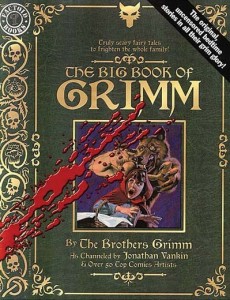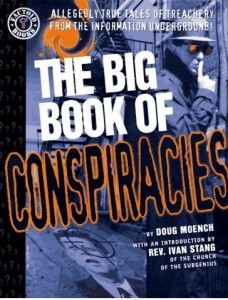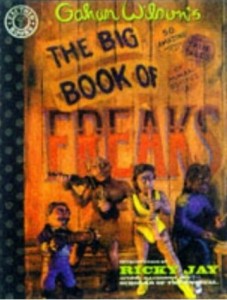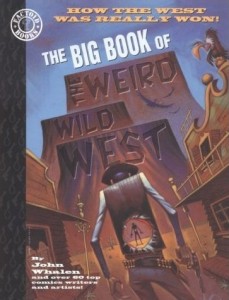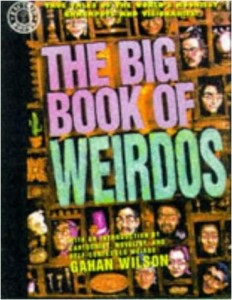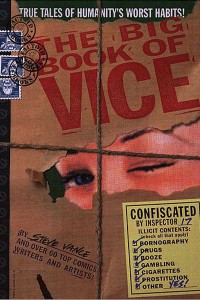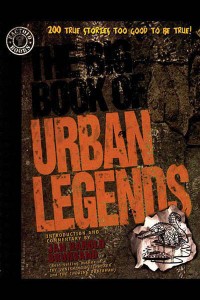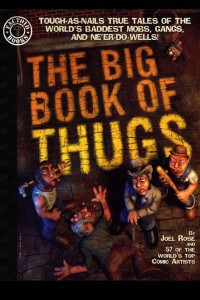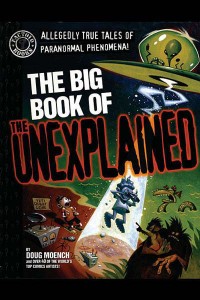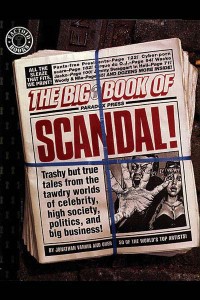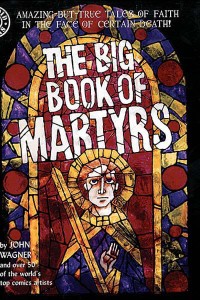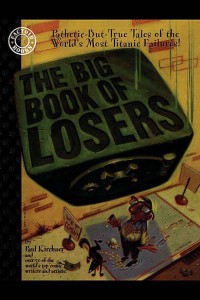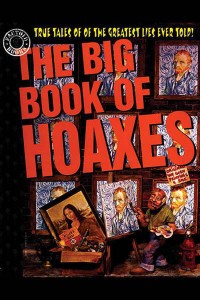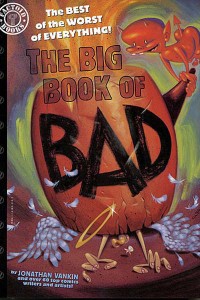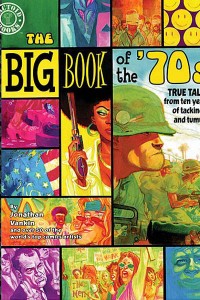The Big Book of the ’70s, by Jonathan Vankin (Paradox Press, 2000)
The Big Book of Bad, by Jonathan Vankin (Paradox Press, 1998)
The Big Book of Conspiracies, by Doug Moench, (Paradox Press, 1995)
The Big Book of Death, by Bronwyn Carlton (Paradox Press, 1995)
The Big Book of Freaks, by Gahan Wilson, et al. (Paradox Press, 1996)
The Big Book of Grimm, by Jonathan Vankin (Paradox Press, 1999)
The Big Book of Hoaxes, by Carl Sifakis, et al., (Paradox Press, 1996)
The Big Book of Little Criminals, by George Hagenauer, et al. (Paradox Press, 1996)
The Big Book of Losers, by Paul Kirchner (Paradox Press, 1997)
The Big Book of Martyrs, by John Wagner (Paradox Press, 1997)
The Big Book of Scandal, by Jonathan Vankin (Paradox Press, 1997)
The Big Book of Thugs, by Joel Rose (Paradox Press, 1996)
The Big Book of the Unexplained, by Doug Moench, (Paradox Press, 1997)
The Big Book of Urban Legends, by Jan Harold Brunvald, adapted by Robert Loren Fleming and Robert F. Boyd, Jr. (Paradox Press, 1994)
The Big Book of Vice, by Steve Vance (Paradox Press, 1999)
The Big Book of The Weird Wild West, by Steve Vance and John Whalen (Paradox Press, 1998)
The Big Book of Weirdoes, by Carl Posey (Paradox Press, 1995)
It’s no secret that we live in an increasingly bizarre, inexplicable, unpredictable, and generally messed-up world. How often do we read something in the news, and go ‘Oh, that’s just not right!’ We thrill to urban legends, alternately denouncing and upholding them, doing our part to propagate stories of alligators in the sewers and poodles in the microwave. We spread around stories about the Darwin Awards, given out to people who go above and beyond the call of duty to remove themselves from the gene pool in spectacularly messy and often embarrassing ways. We tell jokes about public figures, and examine every crack in the facade of society. In short, we’ve done a lot with free will, most of it strange.
If that’s not enough, the world itself seems to conspire against our sanity. Prehistoric serpents swim in the lakes, hairy monsters stalk the woods, crop circles and UFOs are spotted frequently. Just when you think you’ve got a handle on reality, it comes back to bite you in the rear, as it were.
Between 1994 and 2000, Paradox Press, an imprint of DC Comics, released a set of books collecting and examining the weirdest, wackiest, most outrageous material they could find, ranging across the spectrum of popular culture, obscure history, embarrassing moments in society, grim (and Grimm) fascinations, and that part of our soul that we never, ever listen to enough.
Seventeen books in all have been released to date in the Big Book series, seventeen distinct chapters in an encyclopedic compendium of strange.
The format is uniform across the line. Each is the size of a magazine, weighing in at 200 pages, give or take a few. These are well-designed, sturdy volumes which will look good on any shelf. Essentially, they’re graphic novels, with the numerous entries in each book written either by one author or one of several, and illustrated by any one of dozens of different artists. That’s right, one book can include upwards of 70 artists or more, featuring a wildly varying range of styles. While listing them all would be prohibitive, some regular and familiar names include Gahan Wilson, Sergio Aragones (of Mad Magazine and Groo fame), Eddie Campbell (the From Hell graphic novel), Phil Jiminez (current writer and artist of Wonder Woman), Colleen Doran (A Distant Soil), Frank Quietly (The Authority, New X-Men), and so many more. Those with any knowledge of comic books, graphic novels, or alternative media will likely see quite a few familiar names and styles here.
Each book has its theme and sticks to it, with the remarkable result of maintaining very little overlap between books. As for those specific themes, we’ll address each book individually. For the ease of sanity, I’ve chosen to go in alphabetical order, since they can be read in any order or way you desire.
The Big Book of the ’70’s is by Jonathan Vankin, who may have done more Big Books than any other writer. The theme is, yes, you guessed it, that fabulously tacky, turbulent time of change that managed to both embarrass and enrapture society. Vankin covers everything from fads (sex, partying, fashion, disco, streaking, and the ever-popular useless crap) to people (such as Evel Knievel, Burt Reynolds, John Lennon, The Fonz, and Jimmy Carter). There’s women’s liberation, Patty Hearst, the energy crisis, the Moonies, Skylab’s demise, Son of Sam, and the Iran Hostage Crisis. There’s the entertainment explosion: McDonalds, baseball, Sesame Street, glam rock, punk rock, monsters of rock. There’s the Bicentennial, Richard Nixon, and “jiggle” shows like Charlie’s Angels. This book manages to capture all of the quintessential moments, fads, celebrities and incidents that made up this decade. Folks, this is the decade I was born into, and I’m perversely glad I don’t remember it, some days. However, as uncomfortable as some of these things seem now (disco and leisure suits, for example), they’re valid and fun to think back on. Like all the books in the series, this is an entertaining look at an odd point in our history.
Jonathan Vankin also gives us The Big Book of Bad, which takes a look at things that maybe we really should have thought through better. First we have bad guys, such as Pol Pot, Stalin, Himmler, Basil the Bulgar Slayer, and the worst of the Roman emperors. Then we move over to look at a few of literature’s worst offenders: Moriarty, Modred, Long John Silver, Dracula, and more. After that, the book takes on entire groups of people based on really bad ideas, such as the Spanish Inquisition, the Salem Witch Hunt, the KKK, and McCarthyism. There’s bad science, and Bad Sports, a double entendre title to address some of the sports world’s worst people, including Mike Tyson and Ty Cobb. Finally, there’re things that were (and still are) just in bad taste; Liberace is just one of the many examples in this section.
Doug Moench takes over for a twisted and paranoid visit to The Big Book of Conspiracies. Yes, they’re out to get you. Who killed Kennedy? What’s the CIA -really- been up to? What’s the secret of the Face on Mars? What’s the story behind the Magic Bullet? The CIA working with the Nazis, say it ain’t so. How has The Man kept cannabis down when it’s good for so much? Take my word for it, if the truth is in here, it’s struggling to get out. Whether your conspiracy of choice involves the Masons, the Boy Scouts, the Illuminati, or the PTA, it’s bound to be in here. Some of the evidence is pretty convincing, other parts are outlandish, and the book makes no claims to know the one true story. But it’s sure fun to wonder.
Fascinated by death? Bronwyn Carlton certainly is, enough to write The Big Book of Death. She takes us on a gruesome tour of the big sleep, starting with the many methods of capital punishment we’ve thought up. She addresses the myth/reality of postal rage-turned-homicide, teen suicide, stupid murders, and even the infamous Dr, Kevorkian. There’s mass death, with our friends the Black Death, Typhoid Mary, and tuberculosis. There’s weird death, including spontaneous combustion, and dozens of other bizarre ways to kick the bucket, from swallowing pennies to being crushed by ice cream treats. She doesn’t flinch away from the delicate subject of body disposal, detailing practices such as embalming, burial, cremation, mummification, and even cryonics. She leads us on a walking tour of the world’s most notorious cemeteries, including Forest Lawn and Le Cimetiere du Pere Lachaise. No rest for the weary? That’s the title for a chapter that touches on vampires, cannibals, and saving Sakharov’s brain. Do we have issues with death? Dante’s tour of Hell certainly suggests it. Famous last words and near-death experiences likewise suggest that the final moment may be more interesting than we imagined. While the subject matter may be a bit much for the squeamish, and it’s certainly not upbeat, it’s thorough, informative, and interesting.
Let’s try something a little … different. Famed cartoonist Gahan Wilson brings along a few of his friends for The Big Book of Freaks. If they’re weird, they’re in here. From Barnum’s freaks (such as Jo-Jo the Dog-Faced Boy, Jumbo the elephant, and assorted giants) to Siamese twins, from bearded ladies to snake charmers, from geeks to the tattooed prince, from real freaks to manufactured freaks, they’re all here. It’s the genetic upsets, oops, mishaps, and societal flubs that make life so interesting. Given Gahan Wilson’s unique style of cartooning, it’s no wonder he feels such an affinity with the oddities of the world.
Next is something truly near and dear to our hearts here at Green Man: The Big Book of Grimm, adapted from the works of the good Brothers Grimm by Jonathan Vankin. In it he cheerfully retells several dozen of Grimm’s finest fairy tales, sparing us none of the gore or gruesome details. These aren’t the sanitized versions; these are the ones with amputated limbs, horrible deaths, hungry wolves, vicious stepmothers, dysfunctional families, unhappy childhoods, even unhappier marriages, and harsh life lessons. Cinderella is here, as is Rapunzel, Clever Hans, the Goose Girl, Hans My Hedgehog (a humanoid hedgehog, he plays the bagpipes and rides a giant rooster, I kid you not), and many more, both well-known and obscure. If you love fairy tales as they should be, this is the Big Book for you. The book stays true to the material, and the illustrated stories are lovely. Just think twice before showing these to your children…. (I’m still worried by the hedgehog!)
Our next stop is for the gullible, with The Big Book of Hoaxes. Meet the scammers, grifters, con men, too-clever conspirators, and everyone who’s ever tried to pull the wool over someone’s eyes. All our old favorites are here, from the Hitler diaries to the Zion Protocols, from the Cottingley Fairy photos to the Piltdown Man, from the Boxer Rebellion which started as a way to sell newspapers to get-rich-quick schemes. Meet the people who wanted to saw Manhattan in half, and the original cloned human. These are very naughty people by any standards, experts at separating a man from his money, and often from his credibility as well. Pickpockets, mall check hustlers, badgers and pigeons, they’re all here.
On a like note we have The Big Book of Little Criminals, written by George Hagenauer and several others. Not everyone can be a successful major criminal. This book is dedicated to all the small-timers, “thugs, mugs, and slugs” and more.From small-time hoods to hustlers, from forgers to fakers, from ‘disorganized’ crime to the most dangerous women in the field, and finally to some spectacular heists, this one runs the gamut. Whether it’s trying to buy Portugal, counterfeit one-dollar bills, steal Arizona, swipe the Mona Lisa, get sent up the river, or hijack an airplane, these guys have done it: Al Capone, Ma Barker, D. B. Cooper. Louie “Pretty” Amberg, the ugliest gangster in town, shares space with “Dasher” Abbandando, the fastest killer on the block. These people have big dreams, but they don’t always follow through. And when they do, who knows what’ll happen? This is for all the Criminology majors out there.
If you want to feel better about your lot in life, pick up The Big Book of Losers by Paul Kirchner (Fabulous Flops and Fabulous Fads, Nancy A. Collins, and Irwin Chusid. In here are the people who just couldn’t seem to get a break, no matter how they tried. The ones who never made it to the White House, and the ones who did, like James Garfield (killed by medicine) and William Henry Harrison (killed by the weather). Leon Trotsky, who wasn’t welcome at home, and Montezuma, who welcomed the wrong people into his home. There’s the Edsel, the paper dress, and New Coke. Women’s urinals (which make great flowerpots), the picturephone (whose niche has been filled by webcams, if you ask me), smokeless cigarettes (a losing proposition at any price), and the Susie B. dollar coin. Milli Vanilli gets the spotlight, as does Carrie: The Musical. Look back at Custer’s Last Stand, the Maginot Line, and Watergate. Even science has its blunders, when you stop to consider the pneumatic subway, Edison’s cement housing, Mark Twain’s disastrous investments, and Howard Hughes and the infamous Spruce Goose wooden airplane. There’re lost explorers and downed airmen, screwed-up pirates, and mutineers. This book proves we can’t all be winners.
How willing are -you- to die for your beliefs? John Wagner tells the stories of over four dozen men and women who’ve sacrificed their lives in the line of duty, in The Big Book of Martyrs. From apostles to disciples, we look at John the Baptist, Peter, Stephen, Paul and Bartholomew. Try some of the other martyrs: Clement, Ignatius, Polycarp, Laurence, Vitus, Agnes or Blaise, who all met their messy ends in the age of persecution. From popes and kings to slaves and gardeners, we have Thomas Becket and Thomas More, Agatha and Wenceslas. We have soldiers who turned the other cheek, such as Alban, Edmund, Olaf and Joan of Arc. We have the legendary saints: Christopher, Valentine, George, Philomena, and of course Ursula and the 11,000 virgins. (There’s a band name for you!) Even today we have martyrs, whether it’s in Vietnam or Uganda, North America or Nagasaki. If your interests lie in religious trivia, or just in general curiosity, this is a fascinating, if occasionally depressing, book. You’d think we could all just get along….
So maybe losers and martyrs aren’t your thing. Maybe you like seeing people get what they deserve. Jonathan Vankin is back with The Big Book of Scandal! to enlighten us and expose the stupid and unlucky. Everyone in this book has feet of clay: Fatty Arbuckle, Charlie Chaplin, Ingrid Bergman, Heidi Fleiss, Woody Allen, even Rudolph Valentino, all examples of Hollywood’s less stellar moments. Maybe you’d rather see Jimmy Swaggart, or Jim and Tammy Faye Bakker, or O. J. Simpson, or Michael Jackson get their comeuppance. What about the Iran-Contra affair, the business at Watergate, the great mistakes of the Kennedy family, philandering politicians? Oh yes. It’s all in here. Every last blot and blemish and instance where someone got caught with their hand in the cookie jar … or down the intern’s pants. There’s bad bankers, screwball scientists, and even the dangers of cyberporn, back before it really became an issue. Never before have so many been exposed for so little. Although exposed is such a … sensitive term for some of these poor people.
Joel Rose gives us a wry look at some other bad people in The Big Book of Thugs. Starting with the legendary cult of the Thugees, this book details all of those groups and individuals who’ve made their living terrorizing others. Gangs, posses, mobs, societies, families, and random gatherings are included. Some of these people make me scared to go outside. There’re stranglers, regulators, lynchers, rustlers, and spankers, roughnecks and more. Enjoy getting to know the nastiest men and women around, from a safe distance.
Doug Moench returns with The Big Book of the Unexplained. Like the Big Book of Conspiracies, this book looks at the truly bizarre things that make life as we know it so exciting. Alien abductions and UFOs have their place beside the Loch Ness Monsters, the Men in Black, the Mothman, the Goatsucker, and Bigfoot. Ghosts and bizarre creatures, even James Dean’s cursed car, are to be found here. Go ahead, you know you want to take a peek at the Kentucky goblins, kraken, and random examples of what could only be a great cosmic trickster having a laugh at our expense. This is good stuff, folks, whether it’s real or not.
Next up are 200 stories brought forth from the works of famed folklorist Jan Harold Brunvald in what else but The Big Book of Urban Legends. Lovingly recreated in cartoon format are all of the classics. Spider-infested hairdos, choking Dobermans, the “baby train,” resubmitted term papers, exploding toilets, microwaved pets, dead roommates, serial killers, sex romps, hitchhikers, exam pranks, and many, many more. If you’ve heard an urban legend, it’s probably in here. It’s great to see what we’ll actually believe to be true, and wonder what might have inspired it. This is definitely one of the best books in a consistently good series.
Still with me? Steve Vance and Dave Stern take us on a tour of all things naughty with The Big Book of Vice. That’s right, it’s some of our favorite things: sex, drugs, alcohol, gambling, tobacco, and sin cities. Mmmm-boy. Pimps and prostitutes, madams and porn kings, cigarettes and cigars, Las Vegas, cocaine, hemp, LSD, Timothy Leary, caffeine fiends, moonshine, marijuana, opium … if it can be eaten, drunk, smoked, snorted, or wagered, it’s probably one of the vices or topics found here. Even comic books and candy and trading cards have their moment. This is a great book to give to your favorite priest … or maybe not. Just don’t think it’s a checklist of things you absolutely must do (like some reportedly do with the Purity Test!). It’s fun to see what we get up to in our spare time … and sobering.
John Whalen and friends escort us back to one of the wildest, weirdest times in American history in The Big Book of the Weird Wild West. It’s all about gunfighters, strange legends and crackpot characters, killers and cannibals. We’re told about the bigger-than-life people who made their livings and legends in that over-the-top period. Back then it seemed people would believe everything, and the dime novels that turned killers into heroes and minor hoodlums into major celebrities didn’t help. In a land without law, anything could, and often did, happen. Now it’s all been put together into one convenient bundle. It may cost more than a dime, but the entertainment value is well worth it.
Finally, we finish up with The Big Book of Weirdos, brought to us by our old friend, Gahan Wilson. You thought your friends were weird? Try these people on for size! Adolf Hitler was weird, but King Ludwig II of Bavaria was kooky. T. E. Lawrence wasn’t exactly normal, while the mad monk Rasputin was legendary for his strange ways. Who was nuttier than a squirrel’s hoard: Edgar Allan Poe, William Burroughs, Franz Kafka, or Aleister Crowley? Trick question, they’re all here. So’s the Divine Sarah Bernhardt, Harry Houdini, and the dashing Isadora Duncan. Hollywood contributes such eccentrics as Clara Bow and Ed Wood, Jr., and society produces Andy Warhol and Salvador Dali. You must be nuts in order to create great things. Why else would Thomas Edison, Henry Ford, and Nikola Tesla (my favorite ‘mad scientist’ of all time) be in here? And what was William Randolph Hearst’s weird factor? What made Sarah Winchester spend decades building a house no sane person could ever live in? How -do- you explain the Marquis de Sade to your friends? Is there any explanation possible for J. Edgar Hoover? And what’s the bizarre, fascinating story of Norton I, Emperor of the United States? If you want to find out, you may want to try this book.
That wraps it up. Seventeen books, seventeen different collections of weird, wild, bizarre, unexplained, tawdry, criminal, legal, illegal, mysterious, entertaining, amusing, morbid, religious, pathetic, nifty, embarrassing, funky, and otherwise -odd- people, places, events, fads, and themes. If you can’t find at least one to suit your tastes you might want to check your pulse and grab The Big Book of Death just in case.
You should be able to find these books in your local comic store or bookstore. If you have no luck, you can probably find them online. Just look for Paradox Press, an imprint of DC Comics. And have fun.
